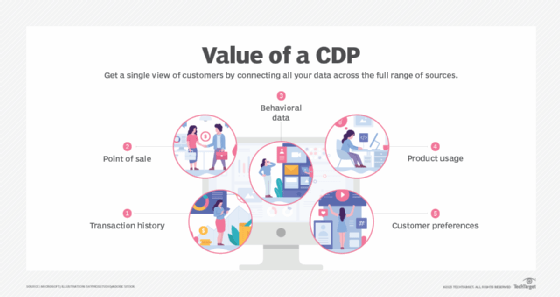
Getty Images/iStockphoto
How to choose a customer data platform
CDPs centralize customer data, which can improve marketing insights. To choose the right CDP, CX leaders can create a team of stakeholders, identify goals and compare products.
Customers use multiple channels, such as vendor blogs, social media pages and live chat, to research and purchase products and services. These channels possess a wealth of useful information organizations can use to improve their sales strategies.
However, this customer journey data can become siloed and difficult to use if organizations have no central repository and analysis platform in place to store and organize it. Customer data platforms (CDPs) help CX teams centralize and make sense of their customer data. These platforms have grown increasingly important for organizations that want to better understand their customers and cultivate meaningful relationships that increase sales.
Most CDPs generally aim to improve customer relationship visibility and sales insights, but different vendor platforms can have distinct features and costs. Business decision-makers should understand these potential differences before they purchase CDP software for their organizations. Although CDP goals can vary from one business to the next, the process of selecting a vendor remains the same.
Discover five steps that can help decision-makers choose the right CDP.
1. Devise a team of stakeholders
Customer data offers value to multiple departments across an organization. In particular, buying teams should include stakeholders from sales, marketing and customer service. These representatives can express their teams' specific wants and needs because they work closely with customer data.
The buying team should also include leaders from the IT department because they must implement the platform and integrate it with existing technologies, such as CRM systems, CX and data management platforms.
2. Understand current and future goals for the CDP
To select a CDP with the right features and integration capabilities, buying teams must first consider the types of data, such as zero-party, first-party and third-party data, available to them. They should also identify which goals the organization hopes to accomplish with this data after they analyze it.
Organizations may use CDPs to achieve the following goals:
- sales and marketing personalization;
- customer categorization and segmentation;
- increased sales conversion rates;
- automation of customer touchpoint processes;
- greater understanding of customer expectations; and
- improved sales and marketing messaging.
Each of these goals requires specific CDP features to accomplish. Common features that can help organizations achieve these goals include the following:
- data collection from multiple online and offline customer touchpoints;
- data cleansing to deduplicate and prepare customer data for consolidated analysis;
- customer preference and identity categorization based on automatically collected customer profile information; and
- AI-powered data analysis that help sales and marketing teams perform the following tasks:
- target specific customers;
- align sales messages with customer preferences;
- calculate expected sales conversion rates;
- identify techniques that build customer loyalty; and
- adjust digital touchpoints to improve customer engagement.
3. Identify potential app integrations
After buying teams identify their CDP implementation goals, they must focus on existing IT infrastructure and determine which types of integrations the CDP can have with existing applications and data sets.
Most integrations use APIs to extract siloed data from various customer engagement platforms and place it into a centralized CDP repository. This data centralization offers buying teams a single source of truth, which lets them evaluate customer data as a whole. It also offers granular analysis and valuable business insights.

4. Compare CDP products
After technology buyers understand their business and technical goals, they can explore the many CDP offerings available on the market that meet their needs. Buying teams can begin initial research online as they review CDP vendor marketing and technical implementation material.
Teams can also reach out to other organizations that have undergone a CDP integration to learn about their decision-making processes and ask about CDP features, benefits and challenges.
When the buying team completes its initial research and selects a shortlist of vendor products, it should reach out to the vendor or a vendor partner to determine which product may work best given the organization's business goals and existing technology environment. Vendor representatives can also explain the technical details of the integration process.
5. Balance CDP features with cost and manageability
Although technology buyers may find one CDP that benefits them from a technological and information analysis standpoint, they must weigh that CDP against other business factors, such as cost. Commercial CDPs can vary greatly in price, and buyers must evaluate whether their organizations can use more advanced platform features or if they could more effectively spend that money elsewhere.
Additionally, stakeholders must consider what type of external expertise, if any, they may require as they integrate the CDP into their organization's infrastructure. Stakeholders should also consider CDP training and ongoing system management because these factors can affect a CDP's ongoing operability and effectiveness.
These steps can help buying teams find the right CDP and use the product to its highest potential. If technology buyers purchase a CDP that doesn't include the right features for their organization's specific needs, marketing and sales teams may struggle to increase revenue. Stakeholders should ensure their CDP meets both business and technical goals.







